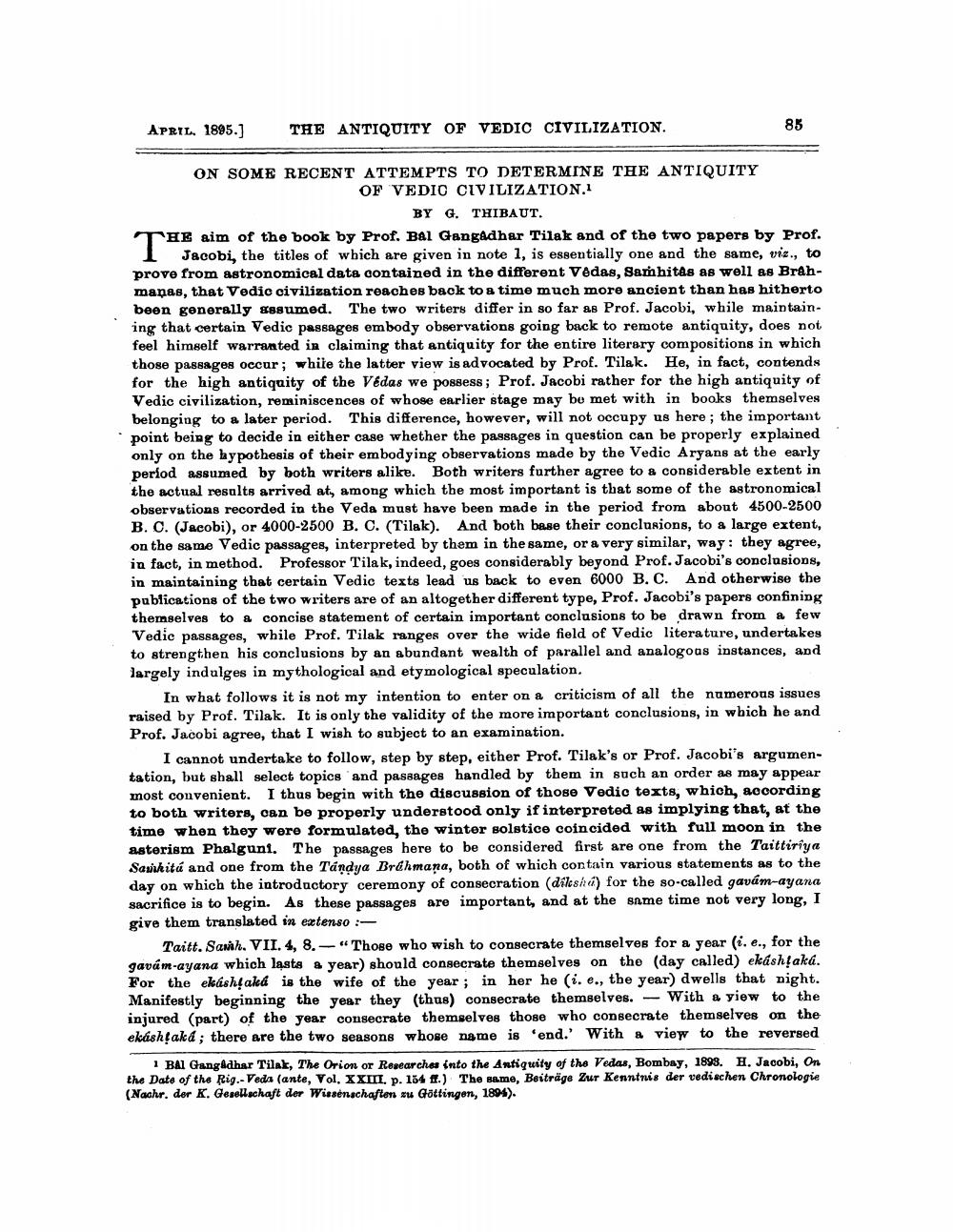________________
APRIL, 1895.)
THE ANTIQUITY OF VEDIC CIVILIZATION
85
ON SOME RECENT ATTEMPTS TO DETERMINE THE ANTIQUITY
OF VEDIC CIVILIZATION.
BY G. THIBAUT. THE aim of the book by Prof. Bal Gangadhar Tilak and of the two papers by Prof.
Jacobi, the titles of which are given in note 1, is essentially one and the same, viz., to prove from astronomical data contained in the different Vedas, Samhitas as well as Brahmanas, that Vedic civilization reaches back to a time much more ancient than has hitherto been generally assumed. The two writers differ in so far as Prof. Jacobi, while maintaining that certain Vedic passages embody observations going back to remote antiquity, does not feel himself warranted in claiming that antiquity for the entire literary compositions in which those passages occur; while the latter view is advocated by Prof. Tilak. He, in fact, contends for the high antiquity of the Vedas we possess; Prof. Jacobi rather for the high antiquity of Vedic civilization, reminiscences of whose earlier stage may be met with in books themselves belonging to a later period. This difference, however, will not occupy us here; the important point being to decide in either case whether the passages in question can be properly explained only on the hypothesis of their embodying observations made by the Vedic Aryans at the early period assumed by both writers alike. Both writers further agree to a considerable extent in the actual results arrived at, among which the most important is that some of the astronomical observations recorded in the Veda must have been made in the period from about 4500-2500 B. C. (Jacobi), or 4000-2500 B. C. (Tilak). And both base their conclusions, to a large extent, on the same Vedic passages, interpreted by them in the same, or a very similar, way: they agree, in fact, in method. Professor Tilak, indeed, goes considerably beyond Prof. Jacobi's conclusions, in maintaining that certain Vedic texts lead us back to even 6000 B.C. And otherwise the publications of the two writers are of an altogether different type, Prof. Jacobi's papers confining themselves to a concise statement of certain important conclusions to be drawn from a few Vedic passages, while Prof. Tilak ranges over the wide field of Vedic literature, undertakes to strengthen his conclusions by an abundant wealth of parallel and analogous instances, and largely indulges in mythological and etymological speculation.
In what follows it is not my intention to enter on a criticism of all the numerous issues raised by Prof. Tilak. It is only the validity of the more important conclusions, in which he and Prof. Jacobi agree, that I wish to subject to an examination.
I cannot undertake to follow, step by step, either Prof. Tilak's or Prof. Jacobi's argumentation, but shall select topics and passages handled by them in such an order as may appear most convenient. I thus begin with the discussion of those Vedic texts, which, according to both writers, can be properly understood only if interpreted as implying that, at the time when they were formulated, the winter solstice coincided with full moon in the asterism Phalguni. The passages here to be considered first are one from the Taittiriya Savikitá and one from the Tándya Brühmana, both of which contain various statements as to the day on which the introductory ceremony of consecration (dilsh) for the so-called gavám-ayana sacrifice is to begin. As these passages are important, and at the same time not very long, I give them translated in extenso :
Taitt. Sanh. VII. 4, 8.- “Those who wish to consecrate themselves for a year (i. e., for the gavá m-ayana which lasts a year) should consecrate themselves on the (day called) ekáshtaka. For the ekáshfaká is the wife of the year; in her he (i. e., the year) dwells that night. Manifestly beginning the year they (thus) consecrate themselves. With a yiew to the injured (part) of the year consecrate themselves those who consecrate themselves on the ekáshtakd ; there are the two seasons whose name is 'end. With a view to the reversed
IBAL Gangadhar Tilak, The Orion or Researches into the Antiquity of the Vedas, Bombay, 1893. H. Jacobi, On the Date of the Rig.- Veda (ante, Vol. XXIII. p. 154 ff.) The same, Beiträge Zur Kenntnis der vedischen Chronologie (Nachr, der K. Gesellschaft der Wissenschaften eu Göttingen, 1894).




